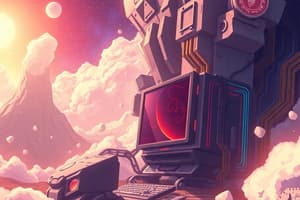Podcast
Questions and Answers
What are the two major components of a computer?
What are the two major components of a computer?
- Operating System and Applications
- Input and Output
- Hardware and Software (correct)
- CPU and Memory
What are the six parts of hardware?
What are the six parts of hardware?
CPU, primary memory, secondary storage, input system, output system, communication system.
Which of the following is NOT a major category of software?
Which of the following is NOT a major category of software?
- Application Software
- Utility Software
- Hardware Software (correct)
- System Software
What are the four different paradigms of computer languages?
What are the four different paradigms of computer languages?
What is the first widely used high-level language?
What is the first widely used high-level language?
Machine languages are the only programming languages understood by a computer.
Machine languages are the only programming languages understood by a computer.
What is the Unified Modeling Language (UML)?
What is the Unified Modeling Language (UML)?
What is the primary purpose of a compiler?
What is the primary purpose of a compiler?
The process of understanding the problem and developing a solution is part of __________.
The process of understanding the problem and developing a solution is part of __________.
Which type of error is the most difficult to find and correct?
Which type of error is the most difficult to find and correct?
Flashcards are hidden until you start studying
Study Notes
Computer Components
- A computer system comprises two main components: hardware and software.
- Hardware refers to the physical equipment of the computer.
- Software consists of a collection of programs that manipulate the hardware to perform tasks.
Major Hardware Components
- Central Processing Unit (CPU): The brain of the computer where most calculations take place.
- Primary Memory: Volatile memory that temporarily stores data and instructions.
- Secondary Storage: Non-volatile storage devices like hard drives and SSDs for permanent data retention.
- Input System: Devices like keyboards and mice that allow users to input data.
- Output System: Devices such as monitors and printers that display or produce output.
- Communication System: Facilitates data exchange between computers and networks.
Types of Software
- System Software: Manages hardware resources and includes operating systems and utility programs.
- Application Software: Divided into general-purpose software (e.g., word processors) and application-specific software tailored for particular tasks or industries.
Evolution of Computer Languages
- Machine Languages: Binary code comprehensible only by a specific computer.
- Symbolic Languages: Developed in the 1950s, utilizing mnemonic symbols for easier programming, e.g., assembly language.
- High-Level Languages: Abstract languages like FORTRAN and COBOL created to enhance programmer efficiency and portability across systems.
Language Paradigms
- Four main programming paradigms:
- Procedural: Focuses on procedure calls.
- Object-Oriented: Organizes software design around data, or objects.
- Functional: Treats computation as the evaluation of mathematical functions.
- Logic: Based on formal logic and rules.
C++ and Paradigms
- C++ is built on the procedural paradigm but supports object-oriented programming through classes and objects.
- Early chapters focus on procedural aspects, utilizing object-oriented features primarily for input/output operations.
Program Design Process
- Involves two key steps:
- Understanding the problem: Review requirements and consult with users for clarification.
- Developing a solution: Outline algorithms and transformations for input to output.
Unified Modeling Language (UML)
- UML serves as a standardized tool for designing, specifying, and documenting aspects of computing systems, particularly in object-oriented programming.
Program Development Process
- Writing and Editing: Uses text editors to create and modify source files containing code.
- Compiling: Source files are translated into machine language through a compiler.
- Linking: Combines user-defined functions with system functions into an executable program.
- Executing: Loads the program into memory for processing input and generating output.
Testing Programs
- Ensures program correctness by testing all instructions and scenarios.
- Test data must be created throughout design and development phases to verify and validate the program.
Program Errors
- Three classifications of errors:
- Specification Errors: Occur due to incorrect or misunderstood problem definitions.
- Code Errors: Result in compiler messages, often straightforward to fix.
- Logic Errors: Difficult to detect and correct errors that arise from faulty program logic.
Studying That Suits You
Use AI to generate personalized quizzes and flashcards to suit your learning preferences.



